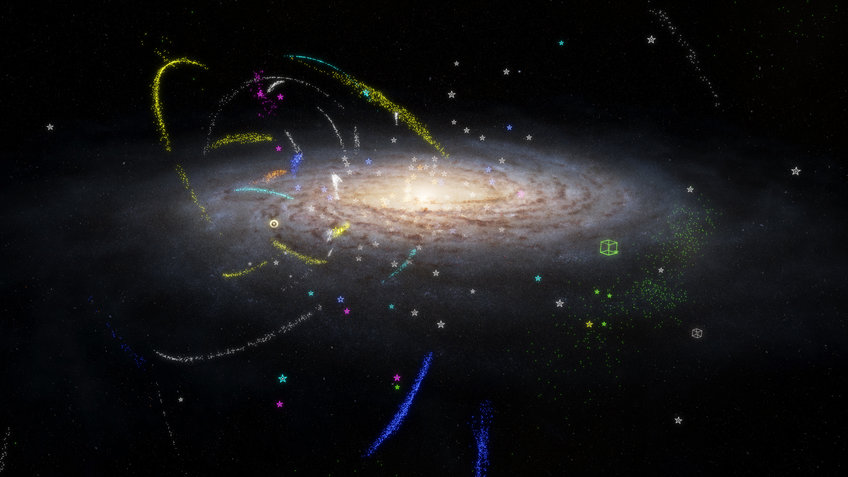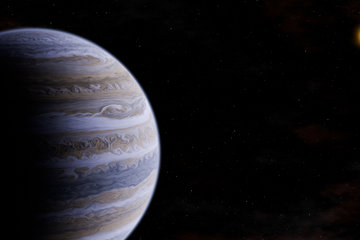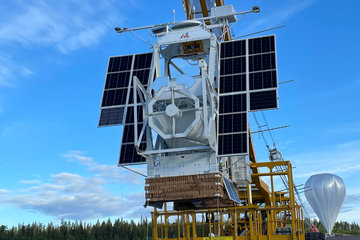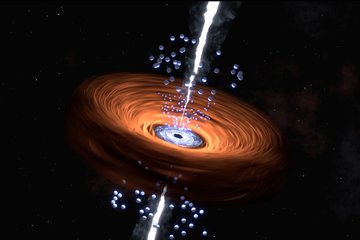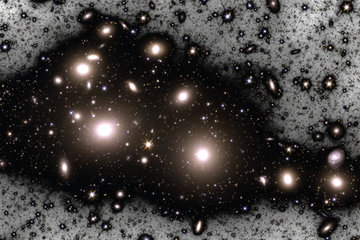Cosmic cannibalism
Astronomers map the Milky Way's intergalactic encounters, one merger at a time
A group of astronomers led by Khyati Malhan of the Max Planck Institute for Astronomy has created an atlas of mergers of smaller galaxies with our home galaxy, the Milky Way. Where earlier studies had reconstructed such mergers "by hand", the new study applied a systematic statistical evaluation of 257 stellar streams, globular clusters and satellite galaxies, using data provided by ESA's Gaia mission, to identify a total of six mergers – one previously unknown, which the researchers named "Pontus". The new results are an important step towards a more complete reconstruction of our galaxy's billion-year history. They have been published in the Astrophysical Journal.

In artist's impressions of the Milky Way galaxy, our home galaxy looks like a brilliant disk of stars, some of which form swirling spiral arms. Less conspicuous, but interesting in its own right, is our galaxy's stellar halo: a vast spherical region of stars that envelops the whole of the galactic disk and the surrounding regions. In the current picture of the formation and evolution of the Milky Way, that halo contains the oldest stars in our galaxy.
The stellar halo is something of an archive of our home galaxy's interactions with its surroundings. Every so often, a smaller galaxy will come so close to the Milky Way that our home galaxy's gravity will capture it. Our own galaxy's gravity will act more strongly on those parts of the small other galaxy that are nearer to us, and more weakly on those parts that are farther away, so that parts such a captured galaxy will typically be drawn out into a longish stream of stars and gas, known as a stellar stream. That stellar stream will then keep orbiting the halo, although over the coming billions of years, its stars will disperse more and more.
Other components of the smaller galaxy are likely to be preserved in our halo as well. Galaxies contain so-called globular clusters: compact clusters of (mostly older) stars, strongly bound by their mutual gravity. Also, galaxies are typically orbited by even smaller satellite galaxies. Globular clusters and satellite galaxies of a smaller galaxy that has merged with the Milky Way are also likely to end up in the Milky Way's halo.
The new study, led by Khyati Malhan, a postdoctoral researcher at the Max Planck Institute for Astronomy [MPIA], is an ambitious attempt to bring data about stellar streams, globular clusters and satellite galaxies together to create a comprehensive "merger atlas" for the Milky Way: a map showing which of these objects are remnants of specific mergers that our home galaxy has witnessed.
The analysis is only possible because recently, a unique data set became available: the early version of Data Release 3 (EDR3) of ESA's Gaia mission. Launched in 2013, and with its first data release in September 2016, Gaia provides so-called astrometric data for more than a billion stars, notably exquisitely accurate locations as well as information about the changes of their position in the sky ("proper motion").
The Gaia mission was already responsible for doubling the number of known stellar streams from about 25 to about 50. Stellar streams are not readily visible in the night sky; in fact, if you were to look at images of some regions of the sky containing a stellar stream, you would be hard-pressed to recognize the stellar stream as such. But Gaia's data about the apparent movement of billions of stars in the sky, complemented in the second data release (DR2) by so-called radial velocity measurements for 7 million stars (showing motion of a star away from us or towards us), allows for the reconstruction of the motion of stars. And nearby stars moving in about the same direction are a tell-tale sign of stars that are part of one and the same stellar stream.
The work by Malhan and his colleagues uses Gaia data not for separate stars, but instead for the stellar streams, globular clusters and satellite galaxies in the stellar halo themselves. The researchers found the necessary data, with the accuracy required for their reconstruction, in the Early Data Release 3 (EDR3) of the Gaia mission, which was published on December 3, 2020.
There are several ways of describing motion in a gravitational potential, but one particular set of quantities, so-called "action variables", proved to be particularly suitable for the task at hand. Similar to physical quantities like energy or angular momentum, which can be calculated from an object's motion, the action variables are somewhat more abstract. But they do have a key advantage: As a smaller galaxy merges with the Milky Way, the action variable values for all of its components – stars, satellites, globular clusters should remain very similar throughout the merger. In turn, an analysis of action variable values gives information as to which objects were originally part of the same galaxy, and thus of the same merger process.
The researchers computed the action variable values from the Gaia EDR3 data for a total of 170 globular clusters, 41 stellar streams and 46 satellite galaxies. For 62 of those objects, their statistical analysis was indeed able to assign them to a total of six different mergers, five of which had been previously known: Sagittarius, Cetus, Gaia-Sausage/Enceladus, LMS-1/Wukong and Arjuna/Sequoia/I'itoi.
In their analysis, the researchers also discovered a merger that, until their work, had been completely unknown. They named the merger, and the galaxy that merged with our galaxy on that occasion, Pontus. The small galaxy Pontus merging with our own moved in the direction opposite to the rotation of the Milky Way's disk, at comparatively low energy – which might hint at a very early date for that particular merger.
The analysis also provided new data about a previously known merger: it showed that three previously known streams were part of the LMS-1/Wukong merger, which was discovered in 2020. Interestingly, those are the most "metal-poor" streams known – metals, in the parlance of astronomy, are all elements heavier than hydrogen and helium. If the progenitor galaxy contained very few of such heavier elements, it is likely to have formed very early in cosmic history. (The merger of that galaxy with our Milky way, though, may have taken place a considerable amount of time later.)
As for the remaining 195 objects, there are several possibilities. Those objects might have been part of much smaller galaxies merging with the Milky Way, which did not leave larger groupings of objects behind. They might also hint at the limitations of the method used. Notably, the researchers found a candidate for a seventh merger "by eye", inspecting their action-variable diagram, while the automatic search overlooked that and two other (known) mergers. In the end, it takes several complementary approaches to reconstruct our home galaxy's cosmic history. But all in all, the six mergers (plus the additional candidate) constitute the bulk of the estimated nine to ten mergers with massive galaxies that our home galaxy has undergone in its lifetime.
What the present analysis does not yet permit is a reconstruction of the chain of events – of the order in which the different mergers occured. This is what the researchers now hope to reconstruct as a next step, by running simulations of how those mergers are likely to have taken place. If all goes well, the comparison between the simulations and the available data could allow for a reconstruction of how the stellar halo of our galaxy was built up over the past billions of years – one merger at a time.
Background information
The results described here have been published as K. Malhan et al., "The Global Dynamical Atlas of the Milky Way mergers: constraints from Gaia EDR3 based orbits of globular clusters, stellar streams and satellite galaxies" in the Astrophysical Journal.
The MPIA scientists involved are Khyati Malhan and Nicolas Martin (also Université de Strasbourg) in collaboration with Rodrigo A. Ibata (Université de Strasbourg), Sanjib Sharma (Sydney Institute for Astronomy), Benoit Famaey (Université de Strasbourg) and others.
